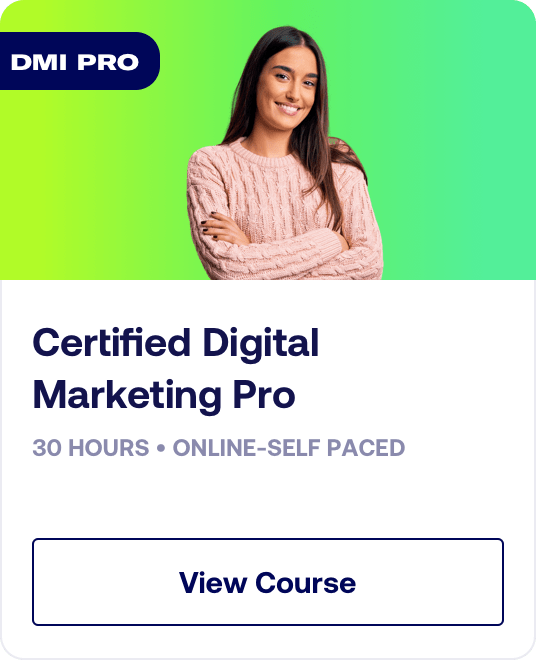Digital Marketing - Study Notes:
Audience definition
The three pillars of a digital strategy are:
- Objectives
- Audience
- Channels
Making sure these pillars align cohesively will help to ensure the success of a digital strategy.
When you are executing a strategy, you are essentially marketing to a target audience, and this relates to your objectives and channel choice. Your objectives determine what audience you target, and your audience determines what channel you use. Knowing the ‘who’, is the bridge between what your hope to achieve and how you will do it. You must know your target audience if you want your strategy to succeed. So customer personas will be an essential part of any strategy document. These personas will be based on the research you have conducted indicating why you are targeting them and how it will be of value to the organization. Audience personas can be a very useful visual aid to include in a PowerPoint when presenting your plan to stakeholders or clients.
To begin, defining your audience is essential, as your strategy and business objectives depend on knowing who you’re marketing to, and how best to communicate with them.
Similarly, knowing exactly who your audience is will also determine which channels to use in your strategy, as there is little value in investing time and budget in channels that your audience doesn’t use.
Understanding your audience
The main research that all marketers use before even thinking about a strategy is audience research. Audience research is designed to establish the size, composition, and characteristics of a group of individuals who are, or could be, potential customers. It’s important to note that this research is about the people and individuals who make up your target audience.
The goal of all audience research is to find consumer insights that can help you deliver on your campaign or business objectives. We are living in an audience-centric world. Where once the brand used to be positioned at the center of the conversation, this has shifted to the audience being at the center of the conversation. The brand is merely part of it.
Researching your audience is very important. You want to be able to understand what your audience loves, their hopes, who they follow and what motivates them, all of which will impact how you connect with them. Because the goal of a digital marketing strategy is to influence the buyer’s journey, marketers need to connect with the audience by knowing what they think, how they behave, and how they live their lives. You should know your audience as well as you know your best friend!
Benefits of audience research
One of the key benefits from conducting audience research is the ability to identify obstacles. For example, are other brands trying to communicate with your audience but not experiencing much success? Why is that?
Being aware of such obstacles can help you to develop appropriate, personalized content that is more relevant to your audience. Moreover, you want to find ways to stay ahead of your customers and discover solutions that anticipate future needs that they may have. Audience research allows you to understand your customers, and ultimately makes you more effective in delivering your digital marketing strategy by catering to their needs.
To help focus your efforts, it is common practice to create a customer persona. This is a description of your ideal customer in terms of motivations, demographics, and channels used to access the internet. Customer personas help digital marketers choose the channels and messaging that will resonate with their ideal customer and efficiently deliver on objectives. Creating a customer persona can help define your audience. Essentially, you are targeting people who are likely to buy from you.
Data types
Before we examine the various tools available to us, let’s look at the data that you’ll want to gather when you conduct audience research.
Audience research typically involves three types of data:
- Demographics
- Psychographics
- Behavioral
It’s important to understand the three types of data because each will help provide different insights into your audience.
Demographics
Demographic data is the hard facts about your audience.
This information is about their relative place within society. It’s not very personal, but it helps you peel back the first layer of understanding about your audience.
The socio-economic data covered under demographics includes:
- Gender
- Age
- Income level
- Occupation
- Marital status
- Location
- Number of children
- Education
- Religion
- Family size
- Ethnicity
- Nationality
- Social class
- Industry
- Number of computers
- Generation
Psychographics
Psychographic data is much more detailed and complex. It includes anything that your audience might be interested in their beliefs, life goals, or opinions. It’s about gaining a deep understanding of your audience’s aspirations so that, when you talk to them, you’re speaking a language that resonates with what they really want.
Psychographics can include:
- Activities
- Interests
- Opinions
- Attitudes
- Values
- Lifestyle
- Loyalty
It’s about their lifestyle and their personality. For instance, maybe you want to reach someone who’s 21 years old and works as an accountant, but also loves basketball.
As there can be many different people types in your audience, you need to conduct demographic and psychographic research so that you really know who they are and avoid making any assumptions or stereotyping. This will help you to navigate away from potential pitfalls and to, for example, avoid running campaigns that target the wrong audience.
Behavioral data
Behavioral data is about how people use your product, or how they navigate your website, and even how they use the different media that you want to use as your marketing channels.
For example, what do they do on Facebook? How long do they stay? Why do they click? Where do they click? All of this is very important because it will allow you to transform the journey of your audience on your website and social media and know exactly where you need to target your effort.
This data can tell you a lot about your customer. For example, when are they on your website? What time are they on Facebook? Maybe it’s in the morning, maybe it’s at night, and you don’t want to miss those opportunities to engage with your customer.
By observing what people do, and how they behave online, using your product or using your competition’s products, you can understand the limitations of the user experience and perception to improve your message and overcome obstacles.
Behavioral data can include:
- Online activities such as social media use
- Website visits
- Product and content use
- Where they click
- What the usual consumer path is on your site
- Other relevant buying habits including brand preferences and product usage
Clark Boyd
Clark Boyd is CEO and founder of marketing simulations company Novela. He is also a digital strategy consultant, author, and trainer. Over the last 12 years, he has devised and implemented international marketing strategies for brands including American Express, Adidas, and General Motors.
Today, Clark works with business schools at the University of Cambridge, Imperial College London, and Columbia University to design and deliver their executive-education courses on data analytics and digital marketing.
Clark is a certified Google trainer and runs Google workshops across Europe and the Middle East. This year, he has delivered keynote speeches at leadership events in Latin America, Europe, and the US. You can find him on X (formerly Twitter), LinkedIn, and Slideshare. He writes regularly on Medium and you can subscribe to his email newsletter, hi, tech.

Bill Phillips
Bill is an international facilitator, trainer, and team coach. He has successfully coached CEOs, board members, directors, executive teams, and team leaders in public and private companies, NGOs, and UN organizations in 15 countries across four continents. He is also the creator of Future-basing®, a highly potent process for building strategy, vision, and cooperation.

By the end of this topic, you should be able to:
- Critically analyse target audiences and objectives to recommend digital channels
- Synthesise information to develop an action plan and digital marketing strategy
- Evaluate the process of planning and formulating a digital strategy





